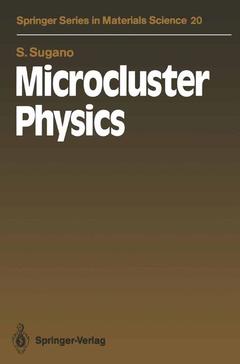Microcluster Physics, Softcover reprint of the original 1st ed. 1991 Coll. Springer Series in Materials Science, Vol. 20
Langue : Français
Auteur : Sugano Satoru
Coordonnateur : Toennies J.Peter

This book aims at providing graduate students and researchers with funda mental knowledge indispensable for entering the new field of "microclus 3 ters". Microclusters consisting of 10 to 10 atoms exhibit neither the pro perties of the corresponding bulk nor those of the corresponding molecule of a few atoms. The microclusters may be considered to form a new phase of materials lying between macroscopic solids and microscopic particles such as atoms and molecules, showing both macroscopic and microscopic features. However, research into such"a riew phase has been left untouched until recent years by the development of the quantum theory of matter. The microscopic features of microclusters were first revealed by ob serving anomalies of the mass spectrum of a Na cluster beam at specific sizes, called magic numbers. Then it was experimentally confirmed that the magic numbers come from the shell structure of valence electrons. Being stimulated by these epoch-making findings in metal microclusters and aided by progress of the experimental techniques producing relatively dense, non interacting micro clusters of various sizes in the form of micro cluster beams, the research field of microclusters has developed rapidly in these 5 to 7 years. The progress is also due to the improvement of computers and com putational techniques, which have made it possible to perform ab initio cal culations of the atomic and electronic structure of smaller microclusters, as well as to carry out computer simulations of their dynamics.
1. What are Microclysters?.- 1.1 Constituent Small Particles of Material.- 1.2 Division of Materials.- 2. Dynamics of Atomic Structure.- 2.1 Solid-like, Liquid-like, or Fluctuating?.- 2.2 Coexistence of Solid-like and Liquid-like Phases.- 2.3 Fluctuating States and Permutation Isomers.- 2.4 Monte Carlo Simulations.- 3. Shell Structure of Metal Clusters.- 3.1 Magic Numbers.- 3.2 The Jellium Model.- 3.3 Theory of Shell Correction.- 3.4 Deformation.- 3.5 Fragmentation.- 4. Other Properties of Metal Clusters.- 4.1 Nonempirical Calculation of Alkali-Metal Clusters.- 4.2 Electronic Structure of Noble-Metal Clusters.- 4.3 Electronic Structure of Transition-Metal Clusters.- 4.4 Divalent-Metal Clusters.- 4.5 Trivalent-Metal Clusters, AlN.- 5. Semiconductor Clusters.- 5.1 Carbon Clusters.- 5.2 Stabilities of Silicon and Germanium Clusters.- 5.3 Nonempirical Calculations for Si6 and Si10.- 5.4 Force and Virial Analysis of Larger Silicon Clusters.- 6. Rare-Gas Clusters.- 6.1 The Magic Numbers for Packing.- 6.2 Helium Clusters.- 7. Molecular Clusters.- 7.1 Photoionization of Ammonia Clusters.- 7.2 Ion-Centered Cage Structure.- 7.3 Negatively Charged Water Clusters.- 7.4 Electron Attachment to van der Waals Clusters.- 8. Miscellaneous Topics.- 8.1 Synthetic Chemistry in a Cluster Beam.- 8.2 Latent-Image Generation.- 8.3 Electron Correlation and Chemical Bonds.- 8.4 Van der Waals and Metallic Mercury Clusters.- 8.5 Prospects of Microcluster Research.- References.
Date de parution : 01-2012
Ouvrage de 158 p.
15.5x23.5 cm
Thème de Microcluster Physics :
Mots-clés :
Atom; Jellium model; catalysis; chemistry; cluster; clusters; electron; electronics; fine paricles; metals; molecule; particles; semiconductor; spectra; structure
© 2024 LAVOISIER S.A.S.


